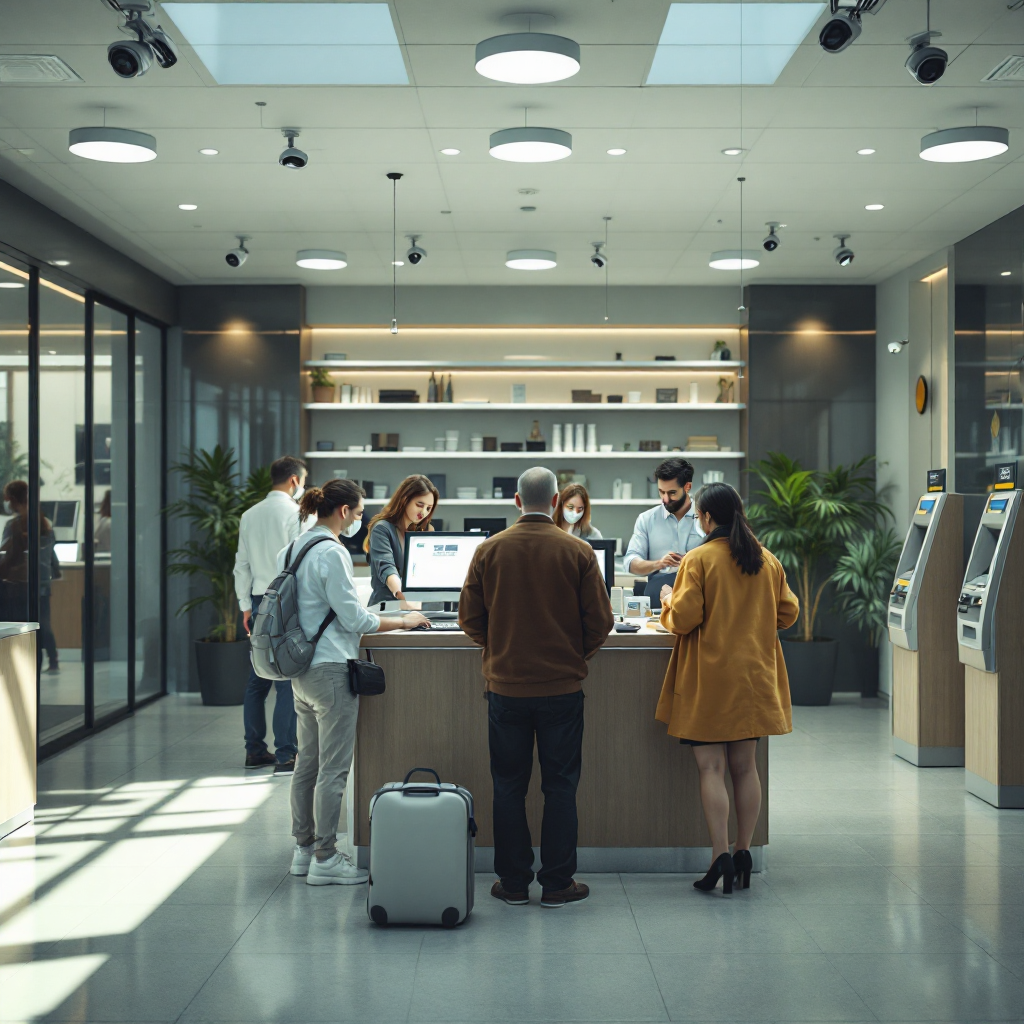AI video analytics in the banking industry
AI video analytics pulls together computer vision, machine learning, and edge compute to turn video into actionable data. First, computer vision extracts objects, faces, cards, and motion from frames. Next, machine learning classifies behaviour and predicts events. Then, systems stream structured events, so teams can act immediately. This blend means banks can analyze video footage automatically. For example, a platform that uses your VMS can convert hours of CCTV into searchable events. Visionplatform.ai offers that approach by using existing cameras and keeping training data local, which helps address regulatory needs and model accuracy.
Market figures highlight rapid adoption. In 2023 the global AI in banking market was valued at USD 19.87 billion, and it is forecast to grow to USD 143.56 billion by 2030, a CAGR near 32% source. This projection shows why banks invest in video analytics. Banks want smarter surveillance, faster fraud detection, and stronger compliance. In fact, 93% of financial institutions expect AI to improve profits over the next five years source. Therefore, investment in intelligent video systems makes financial sense.
Banks can use video analytics to prevent theft, to measure foot traffic, and to improve teller allocation. Also, video analytics in banking supports both security and service goals. It enables banks to reduce losses from fraud and to improve customer satisfaction at branches and ATMs. Importantly, banks can deploy solutions either on cloud or on-premise. Choosing on-premise edge processing keeps sensitive video local, which helps with GDPR and similar rules. For an introduction to on-device camera deployments, see machine vision cameras for computer vision applications resource. Overall, video analytics provides a bridge between security teams and business operations, allowing banks to act faster and to measure impact.
Enhance security and detection with AI-powered surveillance
AI-powered surveillance improves detection of common fraud patterns. For instance, ATM skimming, card tampering, and fraudulent overlays often show small visual cues. Advanced AI algorithms flag those cues in real-time video feeds. Then, staff receive an alert and can respond before losses escalate. Banks that deploy detection models see faster response times and fewer incidents. Some deployments report up to 40% fewer incidents after adding targeted analytics, reducing both loss and remediation cost.
AI video analytics can monitor ATM vestibules, lobbies, and drive aisles continuously. Systems spot loitering, concealment of devices, and unusual hand motions. Also, perimeter monitoring detects unauthorized access or tailgating into secure areas. When alerts arrive, security teams get metadata about the event, time, and object type. This structured data speeds investigations and supports evidence chains for regulators. Visionplatform.ai, for example, streams detections to security stacks and business systems so teams can triage incidents without wading through hours of footage.
Video analytics for banking also supports biometric and object recognition workflows. Banks can combine ANPR/LPR, face detection, and object classes to build layered defense. For high-risk ATMs, analytics can require a secondary check when a suspicious pattern emerges. As a result, response times drop and fraudulent withdrawal attempts fall. Banks that integrate video analytics solution components with their VMS gain a unified incident timeline. This strengthens audit trails and helps meet security in banking requirements. For more on integrating AI with Milestone VMS, see Milestone Systems AI integration resource.

AI vision within minutes?
With our no-code platform you can just focus on your data, we’ll do the rest
Real-time analytics to optimize banking operations
Real-time analytics transform how branches and ATMs run day to day. First, cameras feed live counts of customers and queue lengths. Then, dashboards show where staffing should shift. Banks can optimize teller deployment, reducing wait times and lifting customer satisfaction. Analytics can reduce wait times by up to 30% when used to drive staffing and routing decisions.
Also, AI can generate alerts for teller availability or overload. For example, when a queue exceeds a threshold, the system issues an alert to floor managers so they can open an extra window. These micro-decisions improve throughput. In addition, video analytics systems can feed occupancy and service time metrics into BI tools. That ties cameras to measurable KPIs such as average service time and conversion rates. Visionplatform.ai streams events over MQTT, allowing operations teams to use video as a sensor for dashboards and OEE systems.
Drive-through lanes and ATM vestibules benefit, too. Real-time video processing helps predict service times and allocate staff across lanes. Also, banks can analyze video content to understand peak hours by day and by location. Combining video counts with transaction logs creates a fuller view of demand. Banks can then optimize lane openings, staff breaks, and rota planning. Also, analytics can detect resource waste, like unused kiosks or underused teller windows, and recommend changes. For an example of object detection models used at the edge, see YOLOv10 object detection resource.
Video surveillance and security in banking: compliance and privacy
Banks must balance powerful surveillance with strict privacy and compliance demands. On the one hand, cloud solutions offer scale. On the other hand, on-premises edge processing keeps sensitive video local. Many institutions choose edge processing to meet data sovereignty requirements and to reduce regulatory risk. Visionplatform.ai emphasizes on-prem and edge-first options to support GDPR and the new EU AI Act alignment in practical ways.
Regulators require clear retention policies, access logs, and audit trails. For instance, PCI DSS touches cardholder data that can appear in video footage. Also, GDPR requires data minimization and defined legal bases for processing. Therefore, banks must apply anonymisation, redaction, and strict retention rules. Best practices include masking faces when analytics use is research-only, keeping event metadata separate from raw video, and logging every access. These steps help maintain an audit trail and support compliance.
Additionally, banks should choose video analytics software that supports transparent model configuration and local retraining. Keeping models and data local can reduce the risk of sensitive video leaving the site. Also, banks must document model training, performance, and drift mitigation plans. Regular audits and test datasets ensure models do not degrade. For practical advice on AI governance and supervision, see The impact of AI on the financial sector and supervision source. Ultimately, strong process, clear policies, and on-prem control let banks enhance security while respecting privacy and compliance.

AI vision within minutes?
With our no-code platform you can just focus on your data, we’ll do the rest
Use cases of video analytics software to help banks improve customer experience
Video analytics software creates tangible improvements in in-branch service. First, dynamic signage can display wait times and guide customers to self-service kiosks when lines grow. Second, personalized service triggers can alert greeters when a VIP or an appointment-holder enters. These use cases enhance customer experience and make branch visits more predictable. Also, banks can correlate video events with CRM records to tailor interactions and to measure impact.
At ATMs, analytics detect obstructed cameras, card skimming installations, and suspicious behaviors. When analytics detect tampering, the system issues an alert and can lock the ATM or pause transactions pending verification. This helps in preventing fraud and reduces losses for banks and customers. Also, touch-screen interaction analysis at kiosks can reveal common points of friction. Banks can use that insight to rework UI flows and to reduce failed transactions.
Drive-through banking gains efficiency through queue prediction and service time optimisation. Cameras track car counts and predict wait times. Then, systems route staff or open additional lanes. In all these instances, banks can transform video into operational signals. For more examples of AI camera deployments and PPE or safety detection, see enhancing workplace safety with AI-powered PPE detection solutions resource. Ultimately, video analytics offers a way to measure and to improve customer satisfaction while keeping operations lean.
Generative ai in banking: the future of ai in banking
Generative AI is shaping the next wave of automation in financial services. For example, generative models can draft incident reports from structured video events. They can also simulate scenarios for training staff and testing response plans. This use of generative AI shortens investigative cycles and helps teams learn from synthetic scenarios before they face real incidents.
At a strategic level, banks see AI as a source of competitive advantage. As one analyst put it, “AI is reshaping competitive advantage in banking. Predictive, generative, and agentic AI are redefining the foundations of scale, efficiency, and security” source. Also, KPMG observed that “AI analyzes video and data internally to create a more secure and efficient banking environment” source. Therefore, advanced AI and generative capabilities will augment both security operations and banking operations.
Forecasts expect AI in banking to keep expanding. Projections suggest the broader market may exceed USD 379 billion by 2034 source. Yet, banks must manage ongoing challenges. They need continuous model retraining, integration with legacy systems, and careful ethical governance. Banks must also ensure models remain transparent, auditable, and bias-aware. Tools that allow models to train on local VMS footage and to maintain control over datasets help address these risks. Visionplatform.ai supports local model strategies so institutions can keep control, to meet the future of AI in banking with both capability and caution.
FAQ
What is AI video analytics and how does it work in a bank?
AI video analytics uses computer vision and machine learning to interpret video streams. It detects objects, classifies actions, and streams structured events for security and operations teams.
Can video analytics detect ATM skimming and card tampering?
Yes. Analytics models trained on relevant patterns can spot physical tampering and suspicious handling. When a system flags an incident, it can send an alert for immediate action.
Are there privacy risks when using AI for video surveillance?
There are privacy risks if systems store or share raw sensitive video without controls. Best practice uses edge processing, anonymisation, retention policies, and strict audit trails to reduce those risks.
How quickly can AI reduce response times to incidents?
AI can cut detection-to-alert time from minutes to seconds in many cases. This quickening of response often reduces loss and limits escalation.
Do banks need new cameras to adopt video analytics?
Not always. Many platforms can use existing CCTV and VMS to add analytics. However, some deployments use upgraded cameras or edge devices for better accuracy.
How does video analytics improve customer experience?
Analytics reduce wait times, drive dynamic signage, and enable personalised service triggers. These changes lead to faster service and higher customer satisfaction.
What compliance rules should banks consider when processing video?
Banks must consider GDPR, PCI DSS, and local regulator requirements for data retention and access. They should document processing purposes and apply data minimisation where possible.
Can generative AI create incident reports from video events?
Yes. Generative AI can summarise structured detections into readable reports and can simulate scenarios for training. That saves time and standardises findings.
How do banks balance cloud and on-premise analytics?
Banks often use cloud for scale and on-premise for sensitive or regulated workloads. Edge-first approaches help keep sensitive video local while still enabling analytics.
How do I choose a vendor for AI video analytics?
Choose a vendor that supports your VMS, allows local model training, and provides transparent logs. Also pick solutions that stream events to BI and security systems so analytics drive both security and operations.

